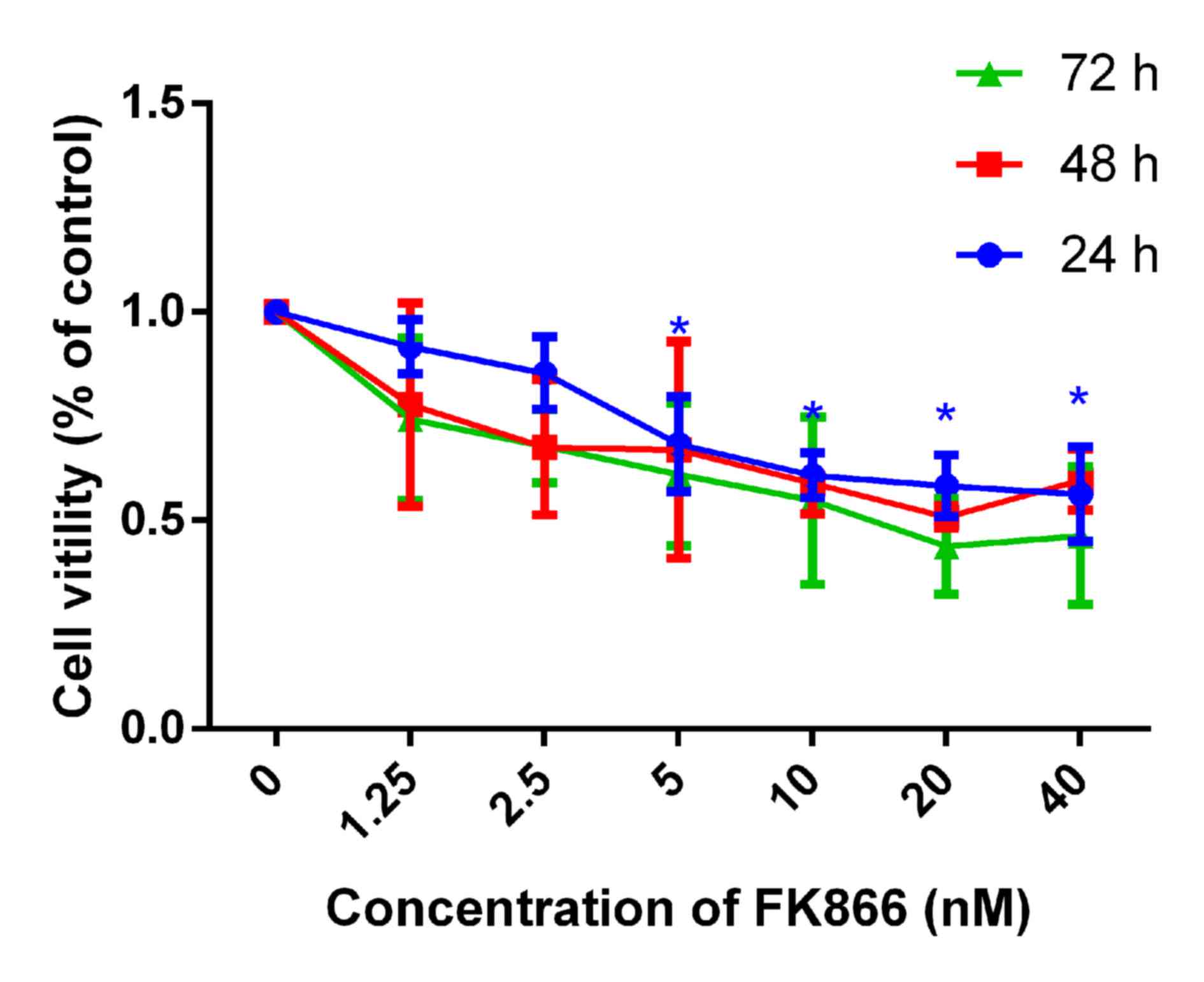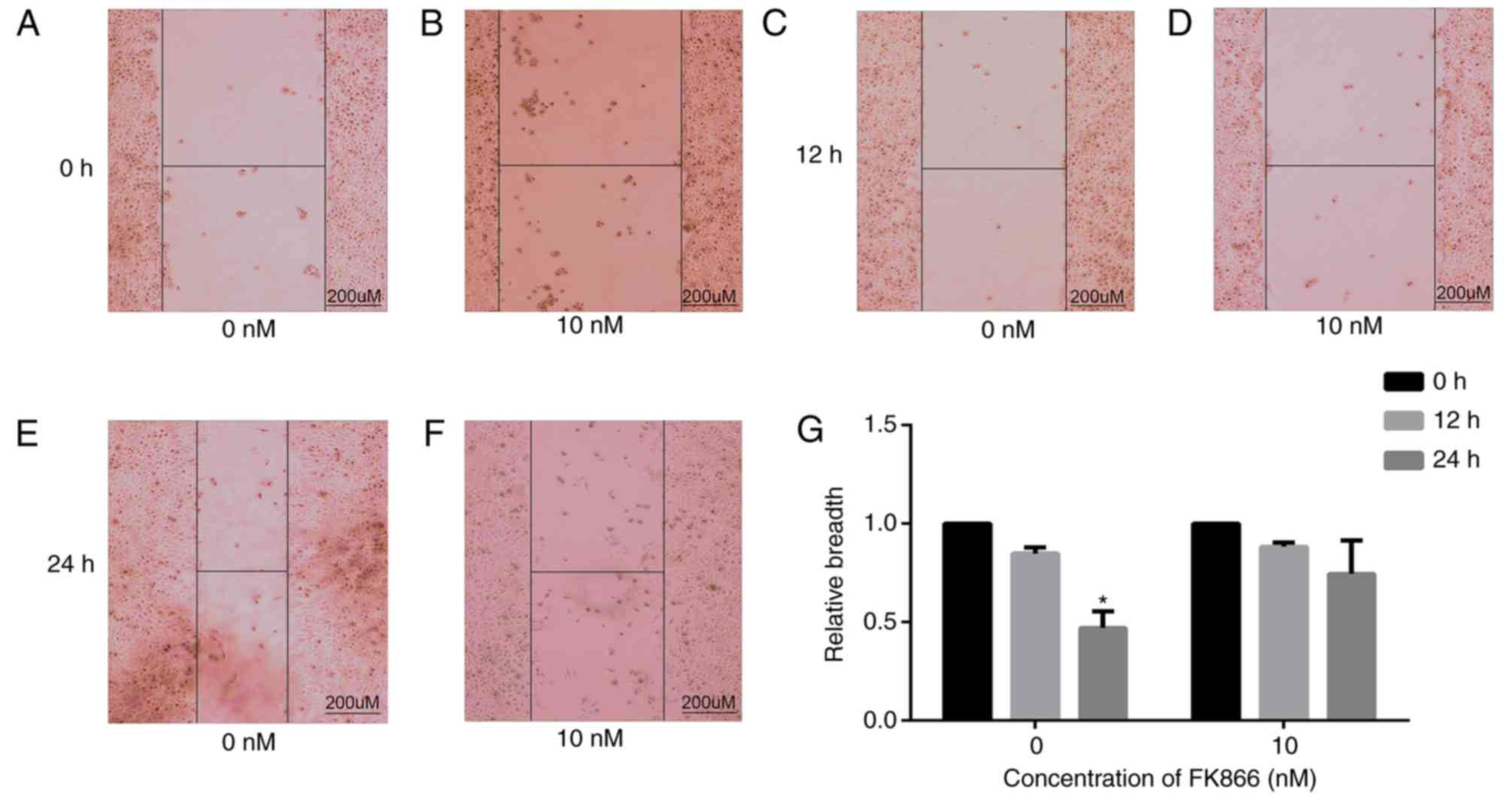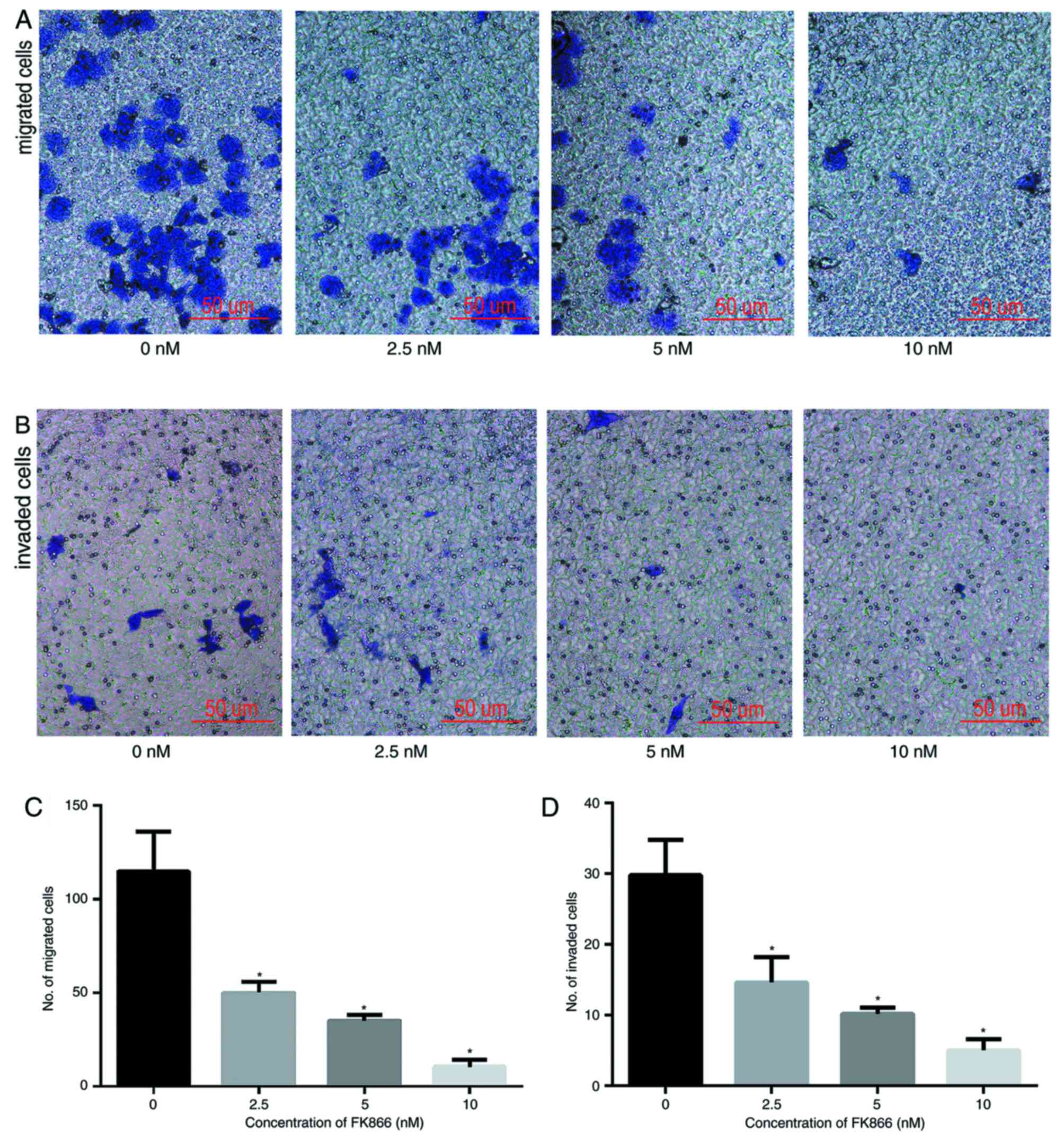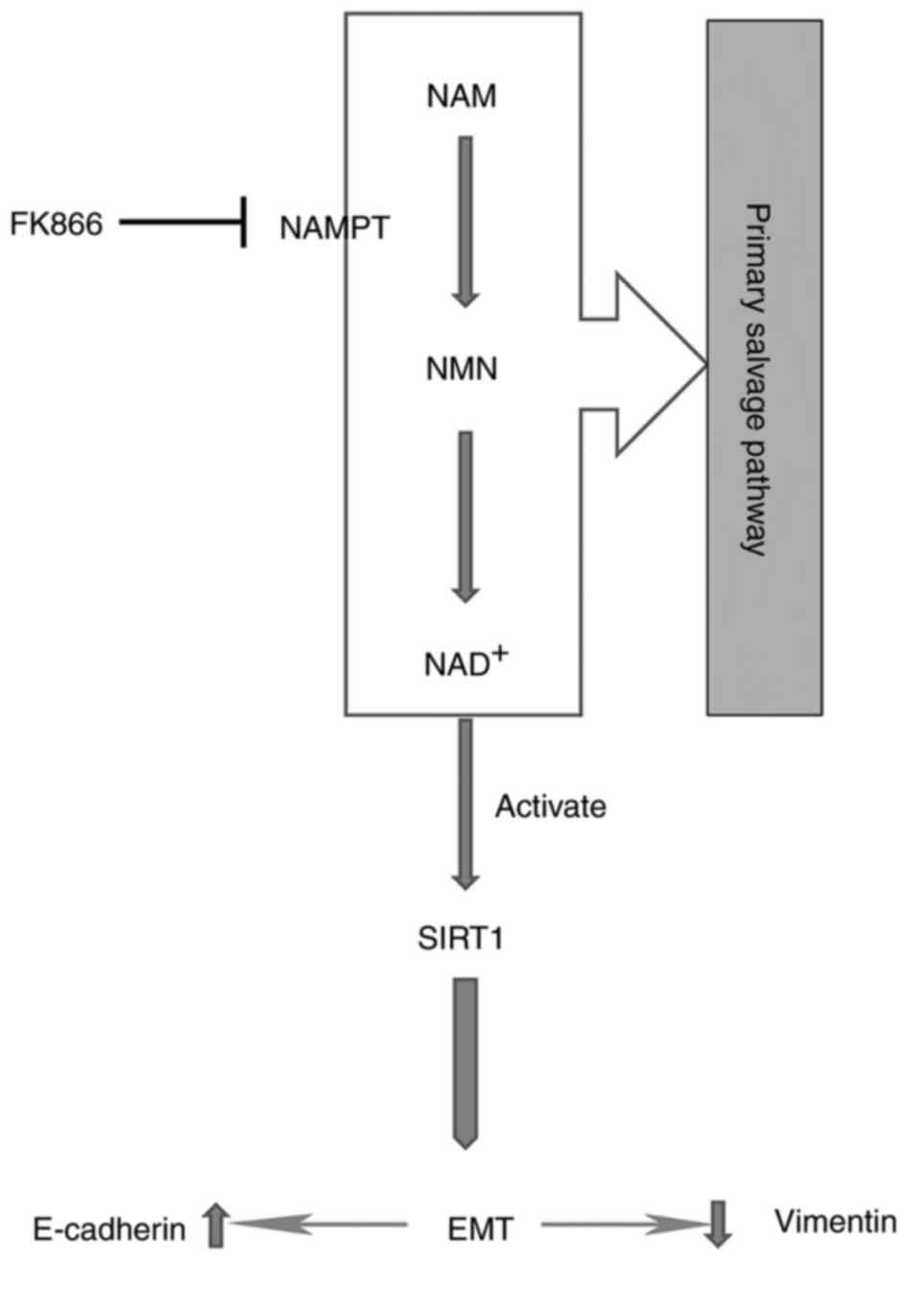|
1
|
Maluccio M and Covey A: Recent progress in
understanding, diagnosing and treating hepatocellular carcinoma. CA
Cancer J Clin. 62:394–399. 2012. View Article : Google Scholar : PubMed/NCBI
|
|
2
|
El-Serag HB: Hepatocellular carcinoma. N
Engl J Med. 365:1118–1127. 2011. View Article : Google Scholar : PubMed/NCBI
|
|
3
|
Zhang Y, Wang W, Wang Y, Huang X, Zhang Z,
Chen B, Xie W, Li S, Shen S and Peng B: NEK2 promotes
hepatocellular carcinoma migration and invasion through modulation
of the epithelial-mesenchymal transition. Oncol Rep. 39:1023–1033.
2018.PubMed/NCBI
|
|
4
|
Liu T, Liu P Y and Marshall GM: The
critical role of the class III histone deacetylase SIRT1 in cancer.
Cancer Res. 69:1702–1705. 2009. View Article : Google Scholar : PubMed/NCBI
|
|
5
|
Jang KY, Noh SJ, Lehwald N, Tao GZ,
Bellovin DI, Park HS, Moon WS, Felsher DW and Sylvester KG: SIRT1
and c-Myc promote liver tumor cell survival and predict poor
survival of human hepatocellular carcinomas. PLoS One.
7:e451192012. View Article : Google Scholar : PubMed/NCBI
|
|
6
|
Bae HJ, Noh JH, Kim JK, Eun JW, Jung KH,
Kim MG, Chang YG, Shen Q, Kim SJ, Park WS, et al: MicroRNA-29c
functions as a tumor suppressor by direct targeting oncogenic SIRT1
in hepatocellular carcinoma. Oncogene. 33:2557–2567. 2014.
View Article : Google Scholar : PubMed/NCBI
|
|
7
|
Liu G, Bi Y, Shen B, Yang H, Zhang Y, Wang
X, Liu H, Lu Y, Liao J, Chen X, et al: SIRT1 limits the function
and fate of myeloid-derived suppressor cells in tumors by
orchestrating HIF-1α-dependent glycolysis. Cancer Res. 74:727–737.
2014. View Article : Google Scholar : PubMed/NCBI
|
|
8
|
Liang XJ, Finkel T, Shen DW, Yin JJ,
Aszalos A and Gottesman MM: SIRT1 Contributes in part to cisplatin
resistance in cancer cells by altering mitochondrial metabolism.
Mol Cancer Res. 6:1499–1506. 2008. View Article : Google Scholar : PubMed/NCBI
|
|
9
|
Chen J, Zhang B, Wong N, Lo AW, To KF,
Chan AW, Ng MH, Ho CY, Cheng SH, Lai PB, et al: Sirtuin 1 is
upregulated in a subset of hepatocellular carcinomas where it is
essential for telomere maintenance and tumor cell growth. Cancer
Res. 71:4138–4149. 2011. View Article : Google Scholar : PubMed/NCBI
|
|
10
|
Hao C, Zhu PX, Yang X, Han ZP, Jiang JH,
Zong C, Zhang XG, Liu WT, Zhao QD, Fan TT, et al: Overexpression of
SIRT1 promotes metastasis through epithelial-mesenchymal transition
in hepatocellular carcinoma. BMC Cancer. 14:9782014. View Article : Google Scholar : PubMed/NCBI
|
|
11
|
Lee Y, Drake AC, Thomas NO, Ferguson LG,
Chappell PE and Shay KP: Dietary resveratrol increases mid-life
fecundity of female Nothobranchius guentheri. Comp Biochem Physiol
C Toxicol Pharmacol. 208:71–76. 2018. View Article : Google Scholar : PubMed/NCBI
|
|
12
|
Gerner RR, Klepsch V, Macheiner S, Arnhard
K, Adolph TE, Grander C, Wieser V, Pfister A, Moser P,
Hermann-Kleiter N, et al: NAD metabolism fuels human and mouse
intestinal inflammation. Gut. 67:1813–1823. 2018. View Article : Google Scholar : PubMed/NCBI
|
|
13
|
Grubisha O, Smith BC and Denu JM: Small
molecule regulation of Sir2 protein deacetylases. FEBS J.
272:4607–4616. 2005. View Article : Google Scholar : PubMed/NCBI
|
|
14
|
Schuster S, Penke M, Gorski T, Gebhardt R,
Weiss TS, Kiess W and Garten A: FK866-induced NAMPT inhibition
activates AMPK and downregulates mTOR signaling in hepatocarcinoma
cell. Biochem Biophys Res Commun. 458:334–340. 2015. View Article : Google Scholar : PubMed/NCBI
|
|
15
|
Alaee M, Khaghani S, Behroozfar K, Hesari
Z, Ghorbanhosseini SS and Nourbakhsh M: Inhibition of nicotinamide
phosphoribosyltransferase induces apoptosis in estrogen
receptor-positive MCF-7 breast cancer cells. J Breast Cancer.
20:20–26. 2017. View Article : Google Scholar : PubMed/NCBI
|
|
16
|
Mutz CN, Schwentner R, Aryee DNT, Bouchard
EDJ, Mejia EM, Hatch GM, Kauer MO, Katschnig AM, Ban J, Garten A,
et al: EWS-FLI1 confers exquisite sensitivity to NAMPT inhibition
in Ewing sarcoma cells. Oncotarget. 8:24679–24693. 2017. View Article : Google Scholar : PubMed/NCBI
|
|
17
|
Liu HY, Li QR, Cheng XF, Wang GJ and Hao
HP: NAMPT inhibition synergizes with NQO1-targeting agents in
inducing apoptotic cell death in non-small cell lung cancer cells.
Chin J Nat Med. 14:582–589. 2016.PubMed/NCBI
|
|
18
|
Barraud M, Garnier J, Loncle C, Gayet O,
Lequeue C, Vasseur S, Bian B, Duconseil P, Gilabert M, Bigonnet M,
et al: A pancreatic ductal adenocarcinoma subpopulation is
sensitive to FK866, an inhibitor of NAMPT. Oncotarget.
7:53783–53796. 2016. View Article : Google Scholar : PubMed/NCBI
|
|
19
|
Song TY, Yeh SL, Hu ML, Chen MY and Yang
NC: A Nampt inhibitor FK866 mimics vitamin B3 deficiency by causing
senescence of human fibroblastic Hs68 cells via attenuation of
NAD(+)-SIRT1 signaling. Biogerontology. 16:789–800. 2015.
View Article : Google Scholar : PubMed/NCBI
|
|
20
|
Imai S: Dissecting systemic control of
metabolism and aging in the NAD World: The importance of SIRT1 and
NAMPT-mediated NAD biosynthesis. FEBS Lett. 585:1657–1662. 2011.
View Article : Google Scholar : PubMed/NCBI
|
|
21
|
Yang NC, Song TY, Chen MY and Hu ML:
Effects of 2-deoxyglucose and dehydroepiandrosterone on
intracellular NAD(+) level, SIRT1 activity and replicative lifespan
of human Hs68 cells. Biogerontology. 12:527–536. 2011. View Article : Google Scholar : PubMed/NCBI
|
|
22
|
Chiarugi A, Dölle C, Felici R and Ziegler
M: The NAD metabolome- a key determinant of cancer cell biology.
Nat Rev Cancer. 12:741–752. 2012. View
Article : Google Scholar : PubMed/NCBI
|
|
23
|
Bi TQ and Che XM: Nampt/PBEF/visfatin and
cancer. Cancer Biol Ther. 10:119–125. 2010. View Article : Google Scholar : PubMed/NCBI
|
|
24
|
Choupani J, Mansoori Derakhshan S, Bayat
S, Alivand MR and Shekari Khaniani M: Narrower insight to SIRT1
role in cancer: A potential therapeutic target to control
epithelial-mesenchymal transition in cancer cells. J Cell Physiol.
233:4443–4457. 2018. View Article : Google Scholar : PubMed/NCBI
|
|
25
|
Liu L, Liu C, Zhang Q, Shen J, Zhang H,
Shan J, Duan G, Guo D, Chen X, Cheng J, et al: SIRT1-mediated
transcriptional regulation of SOX2 is important for self-renewal of
liver cancer stem cells. Hepatology. 64:814–827. 2016. View Article : Google Scholar : PubMed/NCBI
|
|
26
|
Cheng J, Liu C, Liu L, Chen X, Shan J,
Shen J, Zhu W and Qian C: MEK1 signaling promotes self-renewal and
tumorigenicity of liver cancer stem cells via maintaining SIRT1
protein stabilization. Oncotarget. 7:20597–20611. 2016.PubMed/NCBI
|
|
27
|
Esposito E, Impellizzeri D, Mazzon E,
Fakhfouri G, Rahimian R, Travelli C, Tron GC, Genazzani AA and
Cuzzocrea S: The NAMPT inhibitor FK866 reverts the damage in spinal
cord injury. J Neuroinflammation. 9:662012. View Article : Google Scholar : PubMed/NCBI
|
|
28
|
Grohmann T, Penke M, Petzold-Quinque S,
Schuster S, Richter S, Kiess W and Garten A: Inhibition of NAMPT
sensitizes MOLT4 leukemia cells for etoposide treatment through the
SIRT2-p53 pathway. Leuk Res. 69:39–46. 2018. View Article : Google Scholar : PubMed/NCBI
|
|
29
|
Ju HQ, Zhuang ZN, Li H, Tian T, Lu YX, Fan
XQ, Zhou HJ, Mo HY, Sheng H, Chiao PJ and Xu RH: Regulation of the
Nampt-mediated NAD salvage pathway and its therapeutic implications
in pancreatic cancer. Cancer Lett. 379:1–11. 2016. View Article : Google Scholar : PubMed/NCBI
|















